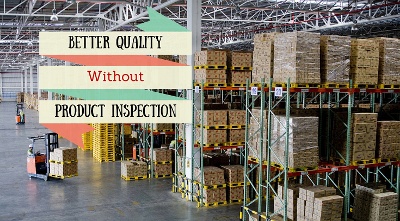 Let’s say you’re importing a lower-cost product like promotional goods, and you don’t want to incur inspection fees. Add in the fact that you’re working with a new supplier and you’re nervous about introducing a third-party inspection partner too early in the relationship. How can you make sure you’re getting the quality you’re paying for?
Let’s say you’re importing a lower-cost product like promotional goods, and you don’t want to incur inspection fees. Add in the fact that you’re working with a new supplier and you’re nervous about introducing a third-party inspection partner too early in the relationship. How can you make sure you’re getting the quality you’re paying for?
You might realize that inspection of your goods prior to shipping is one of the only ways you can rest easy, knowing the quality of your products meets specifications.
But what if you could get better quality without product inspection?
You might be surprised to learn there are other steps you can take to ensure proper quality.
Take a look at these three tips for making that happen:
1. Choosing the right supplier for you
When you forgo independent inspection, it’s just you and the supplier. This means that the factory you choose will have control over your products, and you can’t be sure about what you’re buying until you actually receive the finished goods.
Finding a supplier that you can work well with is the first step to successful cooperation in manufacturing. That’s why you want to choose a factory that’s able to deliver on what they promise. There are several areas you’ll want to focus on to help you decide if any one supplier is more suitable than another (related: 5 Steps to Finding Suppliers in China).
Auditing potential suppliers
Whether you’re visiting a potential supplier yourself or hiring someone else to conduct an audit for you, seeing the facility and investigating certain key areas is an important first step.
A typical factory audit of this kind, sometime called a supplier review, is based on the ISO 9001 standard and looks closely at a factory’s quality management systems. This type of audit can tell you about a supplier's legal status, production capacity, organization and much more. An initial audit is a great way to learn important details about a factory before placing an order. But it may not be a feasible option for more budget-conscious importers.
Visiting your suppliers
You can still learn a lot about a factory by visiting personally. Factory management will  probably want to present the factory in a positive light. But pay close attention to the following areas:
probably want to present the factory in a positive light. But pay close attention to the following areas:
- Organization – does the factory operate efficiently and in an organized manner, or is it messy and chaotic? Has the factory implemented any Lean manufacturing initiatives?
- Production planning – does the factory have a timeline for planning production milestones and different processes?
- Work instructions – do work stations have instructions that clearly show workers how to perform different tasks?
- Material and product inventory – is there an excess of materials and finished goods in storage?
- Equipment – is the factory’s equipment in good working order with regular maintenance performed?
You can learn a lot by observation–just walking through a facility yourself (related: 5 Areas to Look at During a Factory Visit). Visiting a factory also gives you the opportunity to meet management and staff in-person, which can give you a strong start with your new supplier.
Most importantly, a face-to-face meeting with a potential supplier gives you the opportunity to voice your expectations for your product and judge if the supplier can actually meet them.
"A face-to-face meeting with a potential supplier gives you the opportunity to voice your expectations."2. Clearly communicating product expectations
Many importers make the mistake of placing an order with a supplier and then providing certain product requirements or details that the supplier did not have in advance. But this can lead to a number of issues, such as:
- The supplier isn’t able to meet the “new” product requirements, or
- The supplier will have to cut costs to meet your expectations, which often results in some combination of rushed production and lower product quality.
What’s worse, the supplier might not even tell you there’s a problem with your requirements because they might fear losing your business.
The lesson here: always have clear requirements for your products from the beginning.
Don’t assume you're paying for high quality components or that the factory manufacturing your product will give you high quality parts. Always specify the materials which are required for your products and have clear tolerances on what is and is not acceptable.
Issuing a solid PO
Issuing a detailed purchase order (PO) helps prevent unwanted surprises later. A PO shows the official offer that you, the importer, give to your supplier.
"A PO shows the official offer that you, the importer, give to your supplier."An effective purchase order contains critical information a supplier needs to know to produce your goods and meet your expectations for quality and deliverability, including:
- Item details
- Shipping address of the goods
- Payment terms
- Ex-factory date & Incoterms
- Any warranty or returns agreement
- Quality expectations
- Packaging & labeling information
Issuing a detailed PO also helps you hold your supplier accountable for any problems. For example, if your supplier uses a locally sourced PCB when a Japanese PCB should have been used in your product instead, you can point to the PO with the stated requirements that the supplier accepted.. Make sure to be as detailed and specific as possible with your PO (related: The Essentials of a Solid Purchase Order).
Easy and open communication
Communication is key. Even though this is a point we emphasize time and time again, it’s worth repeating here in the context of how to get better quality.

Suppliers are in business, like you, to make money. They generally aren’t maliciously trying to cheat you. But on occasion, you may find your supplier contact is reluctant to deliver bad news. You may be dealing with a “yes man”–someone who tells you what you want to hear, even if it’s not the truth.
The best way to avoid a situation where you’re fed misinformation is to speak directly with your supplier over the phone–or better still–on Skype for a video call. Is your supplier hesitating to commit to a shipping date? Do you get the impression there’s something they’re not telling you? You’ll generally have an opportunity to get extra information that you can’t always get by email alone.
But what if your supplier has difficulty with spoken English?
Most suppliers have English-speaking sales staff, and these are the people you’ll likely be communicating with regularly. If you have real trouble communicating with your supplier by phone and need to fall back on email, make sure your emails are clear. Avoid complicated jargon and idioms your supplier may not understand. And keep your emails simple and to-the-point.
Whatever your chosen method of communication make sure you and your supplier are on the same page. Let them know that you’ll be far more disappointed to have bad news delayed or withheld outright than to be informed as early as possible.
Clearly explain any vital or complex specifications or requirements to make sure they fully understand (related: 3 Barriers to Communication with Suppliers).
3. Approving a “golden” sample before production
Receiving and approving a “golden” sample of product from the factory is one of the easiest ways to evaluate a supplier’s capabilities. Not only can asking for a product sample help you get better quality without product inspection, it also serves as a model of comparison for auditors should you decide to employ inspection.
"A “golden” sample of product from the factory tells you what a supplier is capable of."It’s important to request a sample before placing an order because the sample represents what the factory is capable of making and what the supplier believes perfectly conforms to your specifications. Simply put, the sample generally shows the best they can do. Without seeing a product sample beforehand, how can you be sure the factory fully understands your requirements?
Obtaining and approving a product sample
Here’s the suggested process for obtaining and approving a sample:
- You ask the supplier to send you a product sample BEFORE placing an order

- The supplier sends you one or more product samples to approve for mass production
- You approve a sample, which becomes the “golden” sample for production and send it back to the supplier
- The supplier manufacturers that item to match the sample you approved
And just in case you do decide to hire product inspection help, you’ll want to ensure that approved samples you send are properly sealed to prevent any tampering (related: How to Seal Product Samples). Having the right product sample for reference and comparison can make all the difference.
Conclusion
You might think that better quality comes at a higher price. And generally, that’s the case. The age-old proverb “you get what you pay for” continues to ring true for both importers and end consumers alike.
Here we’ve covered some steps to help you get better quality without product inspection. These tips can help you get what you pay for, on your own.
In the end, you may decide you’d rather have the added reassurance that product inspection provides. But that doesn’t mean you can’t follow these tips and, together with inspection, make sure you’re getting the best quality product possible.
And if you'd prefer to listen to this topic instead, check out this manufacturing podcast!







